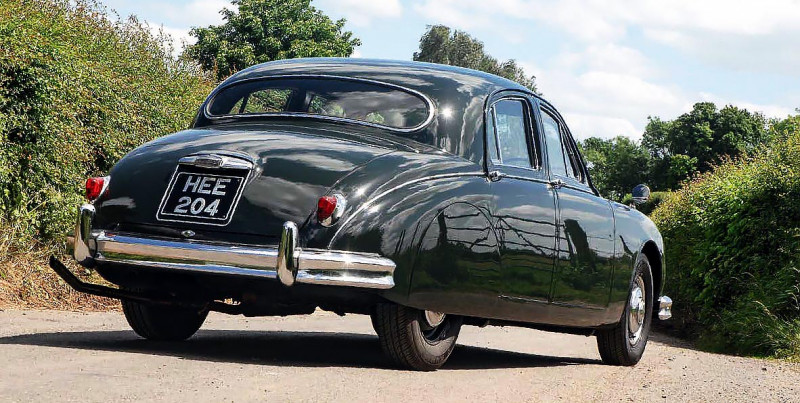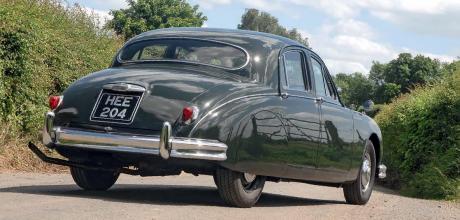1956 Jaguar Mk1 2.4
We enter a time warp and drive a 1956 low mileage 2.4 saloon
WORDS & PHOTOGRAPHY: JIM PATTEN
2.4 ‘MK1’ RETURNS RECOMISSIONED AFTER A DECADE IN STORAGE
A compact Jaguar returns to the road after 10 years slumber
IS THE ORIGINALSTILL THE GREATEST
The world was still recovering from the worst hostilities the globe had seen, and although World War 2 had been over for ten years, reminders of the conflict was everywhere. Rationing had finally ended in the UK late in 1954 but the Brits faced another challenge as fuel was rationed from the end of ’56 until May 1957 as the Suez crisis gripped. Britain then lurched from one catastrophe to another. But the light of hope glowed; dimly at first but soon the warmth of that glow was to bathe a nation in a light of success.
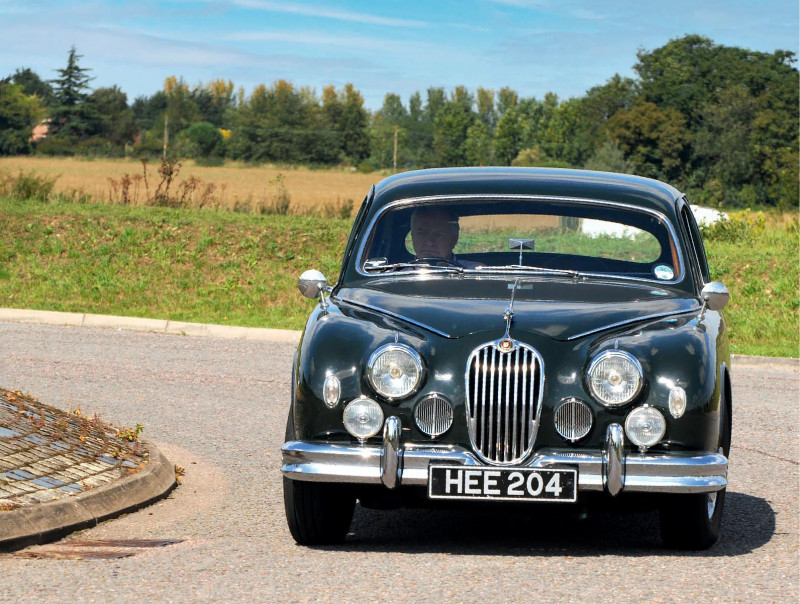
“Back in 1956 it would have been considered reasonably quick, and in the hands of racers like Mike Hawthorn, a proven winner.”
A BRAVE NEW WORLD
Aldous Huxley anticipated a future where humanity would be effectively hatched into divergent roles, each destined to adopt its own function in the future. Jaguar’s brave new world could not have been more different as they sought to offer the buying public freedom of expression with products of unapproachable quality at a price that must have bewildered their competitors. Three years after the war the mighty XK120 was introduced and at the end of 1955 a compact saloon. It was never taken as read that the new saloon would have a short stroke version of the six-cylinder XK engine as the abortive four-cylinder unit – a possible option for the XK 120 to become XK 100 – was resurrected for a look over. But it was not to be, four cylinders would never be a smooth as six so the top of the 3.4 block was sliced off to shorten the stroke from 106mm to 75.5mm giving 2,483cc.
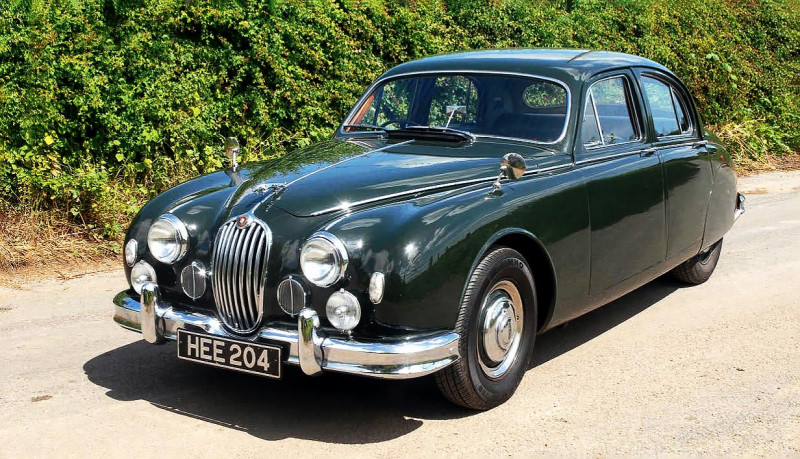
Effectively using the cylinder head from the MkVII with the small exhaust valve and low lift cams, power was hampered by two downdraught Solex 24mm carburettors. Developing 112bhp at a sweet 5,750rpm, it was pretty good for 1955 allowing the saloon to top the ton, an impressive feat in austerity Britain. But it was the body that proved revolutionary, for Jaguar at least.
“Surely it is one of the earliest surviving 2.4 saloons, rarer too in the remarkably well-preserved state...”
Monocoque – or unitary construction – was nothing new. It had been tried in the twenties with the system soon adopted by Citroen. There were many difficulties for Jaguar to overcome as they entered new territory. Following the over-engineering route, the shell proved extremely rigid but with no chassis to isolate the running gear, they had their work cut out. Using a separate crossmember to carry the steering and suspension at the front, it hung on four substantial rubber-mounts that did a splendid job of keeping the road noise at bay. At the rear the clever use of an inverted half-elliptic leaf spring, secured in the centre on rubber pads offered an effective form of insulation, while a sophisticated form of radius arms and a Panhard rod controlled the movement. In a curious style over function application, the rear axle was 4 1/2 inches narrower than the front, a styling feature upon which (Sir) William Lyons would not be moved.
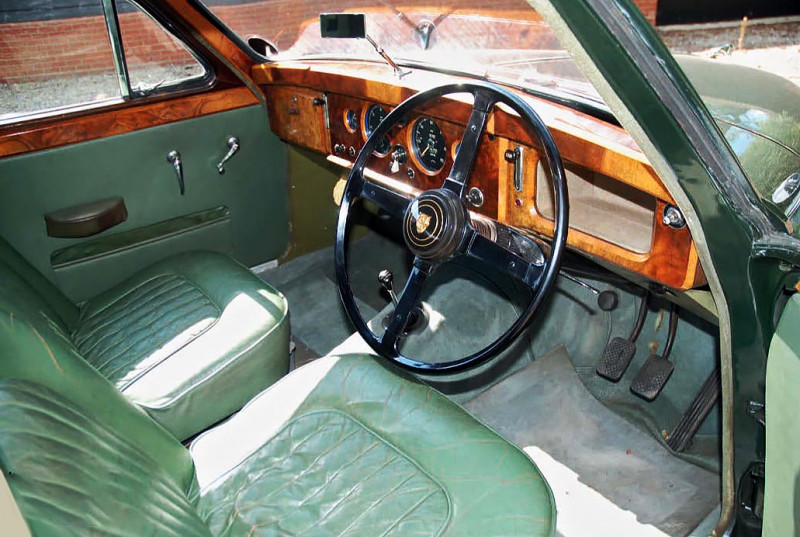
Elsewhere the expected levels of wood and leather followed the normal format and although a standard model was offered without heater, rev-counter and other niceties, we’ve never seen one outside of a press shot. During its production life, the 2.4 – along with the 3.4 – had options for wire wheels, automatic transmission and disc brakes. There was even a tuning booklet for the 2.4, suggesting 3/8-inch lift cams and alterations to the Solex carburettors. Whilst this did offer some gains, the ultimate was to fit the B-type cylinder head with SU carburettors. Styling changes were few; the full spats received cutaways to accommodate wire wheels, while the cast radiator grille gave way to a wider version with individual slats. Production was phased out in 1959 to be replaced by the Mk 2. Total 2.4 saloon production was just short of 20,000.
WAKENED FROM ITS SLUMBERS
It was in June 2004, when the late Les Ely, garage owner and Jaguar racer, set off on a cruise with a classic car magazine under his arm, to pass away the hours relaxing on deck. Well away from everyday life, he spotted an advert for a 2.4 saloon with just 35,000 miles showing. Les had already bought a rusted out 3.4 but was excited at the prospect of a genuine car. Those three weeks took a lot of passing but on returning home a telephone call revealed that the car was still for sale. Setting off immediately he secured the deal.
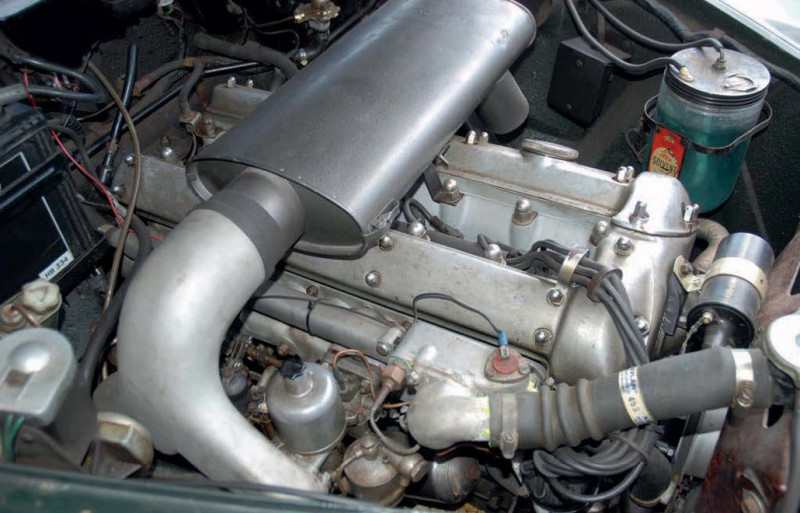
The owner, serious car collector Robert Danny, very kindly allowed Les use of a ramp to check the underside. Fully road legal, Les drove the car home a journey of just under 100 miles. Very few 2.4 saloons (Mk1 was obviously a retrospective name) left the factory in 1955 so this 1956 version represents one of the earliest examples. There’s not a huge history file with this 2.4, there rarely is when the miles are low. But it did have the original buff registration book as well as a copy of the first V5 taking the recorded history right up to the present. George Sleight of Grimsby was the first owner, but he kept it for just four months. The car then moved to London’s St John’s Wood with the second owner where it dwelt some 14-years. Apparently, he’d become ill and so the car was carefully stored just in case his health improved. Sadly, it was not to be and whatever the illness was, he finally succumbed, and the car was disposed of after a lengthy period of probate. Then in October 1970 it was secured by Robert Danny.
Danny was a serious car collector and when he bought his Commemorative E-type from new, it was the only one finished in British Racing Green rather than black. The 2.4 would have been in good company as he bought XKSS 716 (XKD 575) in the same year. Most of the miles had been covered prior to Danny’s ownership as he kept every MoT during his ownership. The first displayed 32,543 miles while the last just 35,810. There were gaps where the car would have simply resided in his collection. Nothing happened between 1971 and 1978, while another ten inactive years passed from ’79. From then it seems that it was brought out on a bi-annual basis. In 34-years the 2.4 had covered a meagre 3,267, an average of just 96 miles a year.
LATER LIFE
Les soon had the car back to his Essex home where the first job was to give the car a thorough once over at his garage, C L Autos. The car was literally faultless, although he did change the ageing cross-ply tyres for radials and completed a full service. He’d also noted that there had been some work. At some point, SU carburettors and a B-type cylinder head had been fitted, possibly the finest period improvement possible. The 2.4 was hardly pressed into immediate action and although Les had the occasional jolly, he barely covered 1,000 miles. Mind you when Les wasn’t running his garage he was usually behind the wheel of his E-type, Lotus Cortina or BMW racecar, leaving precious little time for anything else. But he was adamant that of all his collection, the 2.4 would stay with him forever.
Sadly, we lost Les in February 2021, and this writer helped Steve Peters (a close friend of Les, and formidable preparer of his race cars) find homes for the collection. It was important that each car be placed with a truly understanding owner, and not one to flip it for a quick profit. Fortunately, my good friend, David Sculthorpe, principal at Castrol Classic Oils, was immediately attracted to the 2.4, an emotion enhanced but the amazing condition and wonderful history. David already owns a fabulous S1 E-type fixed head coupe, as well as a 3.4 saloon, a rare survivor with the original drum brakes intact, not to mention a Swallow Gadabout. There is absolutely no doubt that the 2.4 saloon will be as pampered in this phase of its life as it has been in the previous years.
David immediately put the car into the caring hands of Mark Empson, for a sympathetic recommission. Only perishables were changed, like brake and clutch hoses, while the hydraulics had a complete overhaul. Oil and brake fluid are Castrol of course! While Castrol ValveMaster Plus protects against possible ethanol invasion. Methodically going through the car over a period of months, it came out completely refreshed and ready to perform.
Basking in June sunshine, the 2.4 looks magnificent on its full wheel spats – pure fifties. Apart from servicing, this car has not been touched in years. The body looks extremely solid, and while there is the odd parking dent, they are trivial. Inside the valve-radio still hums away happily while signals are picked up by way of a wind-up aerial. The radio valve-pack lives under the passenger seat. In the boot the tool-kit is virtually intact but there are useful spares too. These include a new factory rear door handle still in its original Jaguar box, along with some replacement wheel cylinders for the drum brakes. Even the factory wiring harness tags dangle from the boot loom. Admiration is one thing, but we want to know how this car drives and if a 2.4 can cut it in the modern world. Back in 1956 it would have been considered reasonably quick, and in the hands of racers like Mike Hawthorn, a proven winner. Turn the key, listen to the ticktick of the SU fuel pump, and then briefly touch the starter button to awaken possibly the smoothest version of the XK engine; small yet decidedly sweet. The sound through the exhaust is gentle, and with that wonderful smell that can only emanate from a well-preserved interior, we head out. My immediate reaction is just how much difference the SU carburettors and B-type cylinder head make. Brisk rather than quick the 2.4 is perfectly at home around the lanes. It handles well too in these dry conditions on its radial tyres. There are no other modifications, so it is pleasing that the drum brakes work rather well. Roll through the corners at modest speed is minimal. Up the velocity slightly and roll increases but never to an uncomfortable level.
Out on the dual carriageway the 2.4 gives a good account for itself and in overdrive, finds 80mph an easy – if illegal – cruising speed. At no time did the lack of disc brakes prove a distraction and, although not as sharp as more modern versions, it nonetheless pulled up very well indeed. Back through the lanes where gear-changing is a necessity the Moss ‘box was a treat. Just a blip of the throttle on the down-change to second avoided any embarrassing gear crunch. The drive has been very relaxing, especially on a warm summer day. It also demonstrates what an easy car the 2.4 is to live with. There’s nothing to prove; it’s a delight on the roads and of course, a regular 2.4 is much more affordable than a BRG wire wheeled 3.4, where values continue to soar. But this car is exempt from such sordid details, measured in monetary terms. Surely it is one of the earliest surviving 2.4 saloons, rarer too in the remarkably well-preserved state, something that David is keen to retain. There are a few areas still to deal with. The original auxiliary carburettor choke switch, as manufactured by Otter, was changed at some point to feature a Lucar connection, and will be remedied. Where appropriate, the philosophy of clean and overhaul will be adopted over replace. David will no doubt add to the mileage, but in a measured way. A weekend away choosing quiet country lanes, and the occasional classic car show. By the time this feature appears, it will have returned to ‘Mk 1 day’, hosted by Nigel Webb, a venue that Les took the car some years ago. Adopting an ambassadorial role, it will take pride of place wherever Castrol Classic is represented. We are sure that Les would approve.
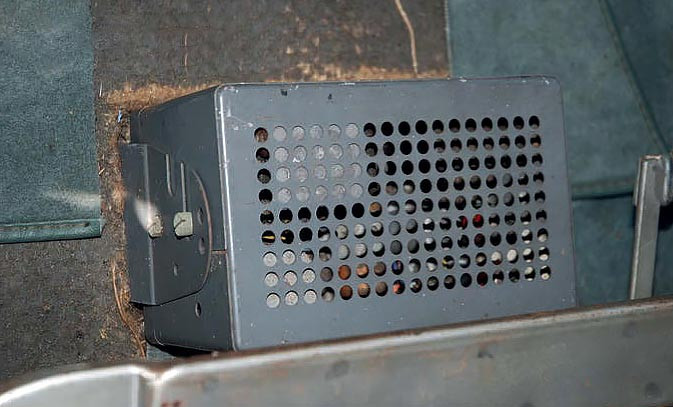
Boot interior is totally original and complete with tools and factory build labels Tool kit is minus its box-spanners.
This ‘Bakelite’ fan shroud is rare and original At some point in its past the B-type cylinder head and SU carburettors have been added Full spats are secured by fasteners, sitting » by original rubbers.
Cast radiator grille and flat headlights are original features.
Beneath the dash lurks this correct and original aerial winder Among the spares is this door handle, still in Jaguar wrapping.
If only we could add smellorama to these pages, the waft of leather is intoxicating Don’t be alarmed, the hum under the seat is the radio valve pack
